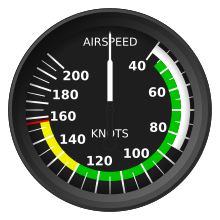This article needs additional citations for verification. (January 2009) |


Indicated airspeed (IAS) is the airspeed of an aircraft as measured by its pitot-static system[1] and displayed by the airspeed indicator (ASI).[2] This is the pilots' primary airspeed reference.
This value is not corrected for installation error, instrument error, or the actual encountered air density,[2] being instead calibrated to always reflect the adiabatic compressible flow of the International Standard Atmosphere at sea level.[1]
It uses the difference between total pressure and static pressure, provided by the system, to either mechanically or electronically measure dynamic pressure. The dynamic pressure includes terms for both density and airspeed. Since the airspeed indicator cannot know the density, it is by design calibrated to assume the sea level standard atmospheric density when calculating airspeed. Since the actual density will vary considerably from this assumed value as the aircraft changes altitude, IAS varies considerably from true airspeed (TAS), the relative velocity between the aircraft and the surrounding air mass. Calibrated airspeed (CAS) is the IAS corrected for instrument and position error.[3]
An aircraft's indicated airspeed in knots is typically abbreviated KIAS for "Knots-Indicated Air Speed" (vs. KCAS for calibrated airspeed and KTAS for true airspeed).
The IAS is an important value for the pilot because it is the indicated speeds which are specified in the aircraft flight manual for such important performance values as the stall speed. These speeds, in true airspeed terms, vary considerably depending upon density altitude. However, at typical civilian operating speeds, the aircraft's aerodynamic structure responds to dynamic pressure alone, and the aircraft will perform the same when at the same dynamic pressure. Since it is this same dynamic pressure that drives the airspeed indicator, an aircraft will always, for example, stall at the published indicated airspeed (for the current configuration) regardless of density, altitude or true airspeed.[4]
Furthermore, the IAS is specified in some regulations, and by air traffic control when directing pilots, since the airspeed indicator displays that speed (by definition) and it is the pilot's primary airspeed reference when operating below transonic or supersonic speeds.
- ^ a b Environmental technical manual (PDF). Vol. I, Procedures for the Noise Certification of Aircraft (3rd ed.). International Civil Aviation Organization. 2018. p. 19. ISBN 978-92-9258-369-9. OCLC 1031377368. Archived (PDF) from the original on 2022-12-22. Retrieved 2022-12-26.
Indicated airspeed. The aircraft velocity as measured by a pitot-static airspeed system calibrated to reflect standard atmosphere adiabatic compressible flow at sea level uncorrected for airspeed system errors.
- ^ a b "Chapter 8, Flight Instruments" (PDF). Pilot's Handbook of Aeronautical Knowledge. U.S. Department of Transportation, FAA, Flight Standards Service. 2016. p. 8. Archived (PDF) from the original on 20 December 2022. Retrieved 26 December 2022.
Indicated airspeed (IAS)—the direct instrument reading obtained from the ASI, uncorrected for variations in atmospheric density, installation error, or instrument error.
- ^ Clancy, L.J. (1975), Aerodynamics, Section 3.9, Pitman Publishing Limited, London. ISBN 0-273-01120-0
- ^ Kermode, A.C.,Mechanics of Flight, 8th Edition – page 64. Longman Group Limited, London ISBN 0-582-23740-8